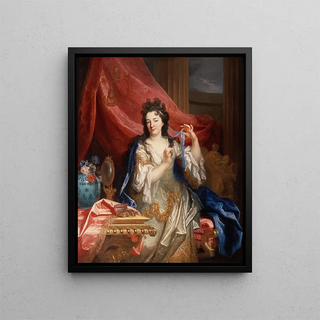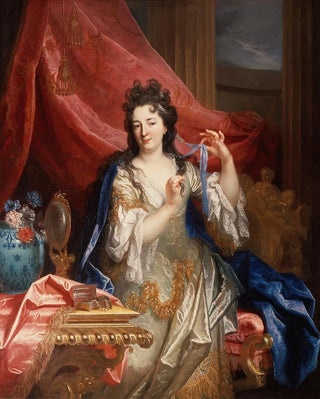Art print | Portrait of a woman - Nicolas de Largillière


View from behind

Frame (optional)
Captivating Introduction
The "Portrait of a Woman" by Nicolas de Largillière is an iconic work of 18th-century French painting, embodying both the elegance and sophistication of its era. This canvas, executed with unparalleled mastery, invites us to delve into the intimate universe of the portraitist, where every detail is carefully crafted to reveal the personality and social status of the model. Largillière, a true virtuoso, manages to capture not only the physical features of his subject but also a deeper essence, an aura that transcends time. Through this art print, we discover an open window into a rich past filled with history and culture, where art intertwines with everyday life.
Style and uniqueness of the work
Largillière's style is distinguished by its naturalistic approach and keen sense of light. In "Portrait of a Woman," warm colors and delicate nuances create a soft and welcoming atmosphere. The composition is carefully balanced, highlighting the woman's face while integrating elements of her environment. The drapery of her clothing, painted with remarkable fluidity, adds a tactile dimension to the piece, while the reflections of light on her skin enhance her radiance. Every brushstroke seems to tell a story, and an immediate connection with the depicted figure is felt. This portrait is not merely an image but a true exploration of identity and feminine beauty, where each detail contributes to the overall harmony of the work.
The artist and his influence
Nicolas de Largillière, born in 1656, is one of the most influential artists of his time, having established himself in the Parisian artistic scene thanks to his exceptional talent. Trained in the traditions of Baroque portraiture, he evolved towards a more personal style, blending realism and sensitivity. His work had a significant impact on portrait painting in France, inspiring many artists who followed in his footsteps. Largillière captured the spirit of his era by emphasizing the values of nobility and bourgeoisie, while incorporating elements of psychology into his representations. His legacy end

Matte finish

View from behind

Frame (optional)
Captivating Introduction
The "Portrait of a Woman" by Nicolas de Largillière is an iconic work of 18th-century French painting, embodying both the elegance and sophistication of its era. This canvas, executed with unparalleled mastery, invites us to delve into the intimate universe of the portraitist, where every detail is carefully crafted to reveal the personality and social status of the model. Largillière, a true virtuoso, manages to capture not only the physical features of his subject but also a deeper essence, an aura that transcends time. Through this art print, we discover an open window into a rich past filled with history and culture, where art intertwines with everyday life.
Style and uniqueness of the work
Largillière's style is distinguished by its naturalistic approach and keen sense of light. In "Portrait of a Woman," warm colors and delicate nuances create a soft and welcoming atmosphere. The composition is carefully balanced, highlighting the woman's face while integrating elements of her environment. The drapery of her clothing, painted with remarkable fluidity, adds a tactile dimension to the piece, while the reflections of light on her skin enhance her radiance. Every brushstroke seems to tell a story, and an immediate connection with the depicted figure is felt. This portrait is not merely an image but a true exploration of identity and feminine beauty, where each detail contributes to the overall harmony of the work.
The artist and his influence
Nicolas de Largillière, born in 1656, is one of the most influential artists of his time, having established himself in the Parisian artistic scene thanks to his exceptional talent. Trained in the traditions of Baroque portraiture, he evolved towards a more personal style, blending realism and sensitivity. His work had a significant impact on portrait painting in France, inspiring many artists who followed in his footsteps. Largillière captured the spirit of his era by emphasizing the values of nobility and bourgeoisie, while incorporating elements of psychology into his representations. His legacy end






